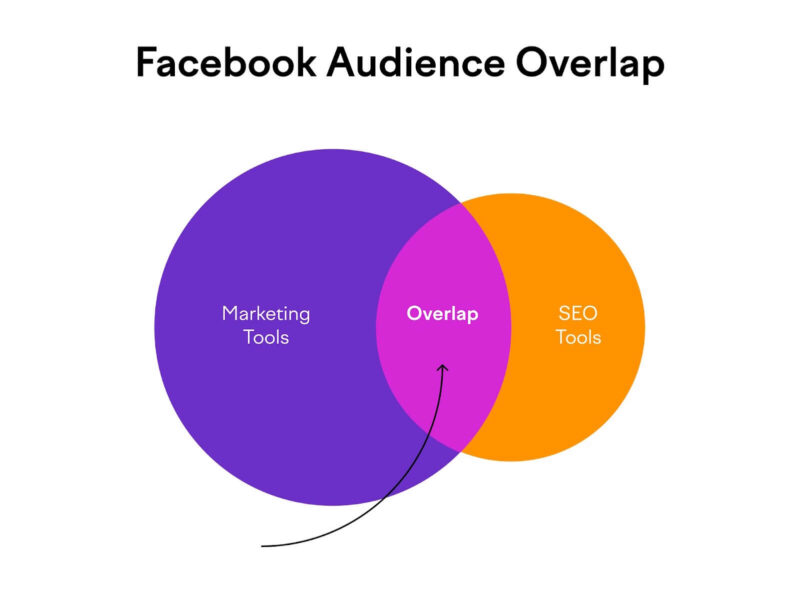
What Exactly is Audience Overlap in Facebook Ads?
Facebook audience overlap Facebook ads, specifically within the realm of Facebook ads, refers to the scenario where multiple advertisements within a company’s campaign are targeting the same individuals on the social media platform.
For instance, consider two ad sets: one directed at those interested in marketing tools, and another aimed at those interested in SEO tools. It’s likely that a significant portion of the audience for SEO tools also falls within the audience interested in marketing tools, leading to audience overlap Facebook ads.
Within the domain of Facebook ads, this situation can lead to a competition behind the scenes, as Facebook determines which ad to display when there’s an opportunity. Consequently, only one ad will prevail in capturing the attention of the shared audience, potentially resulting in decreased performance for the other ad and inefficient use of allocated budget.
The Significance of Avoiding Audience Overlap in Facebook Ads
Ensuring avoidance of audience overlap Facebook ads is crucial. It saves time, effort, and ensures optimal utilization of your allocated budget.
Crafting an ad that never sees the light of day can be disheartening. Moreover, it can skew performance evaluations.
Why does this matter?
Facebook initiates a “learning phase” for each new ad or heavily edited existing ones, conducting various tests to optimize performance.
Identifying an ad in this phase is possible by checking the “Delivery” column in Meta Ads Manager. During this period of experimentation, the ad’s performance tends to be subpar, leading to higher costs per action (CPA).
Typically, the learning phase concludes once the ad reaches a sufficient audience to stabilize performance. However, if the ad receives minimal exposure or none at all, it transitions into the “learning limited” phase, indicating an inability of the delivery system to optimize performance.
Furthermore, your budget may remain underutilized, and the overall return on investment (ROI) could suffer. Ads with overlapping audiences tend to linger longer in the higher-cost learning phase, diminishing the value of each dollar invested compared to campaigns without audience overlap Facebook ads.
Avoiding audience overlap Facebook ads in Facebook ads is thus imperative for maximizing campaign efficiency and ROI.
Factors Contributing to Audience Overlap in Facebook Ads
Some audience overlap Facebook ads is inevitable due to the finite pool of potential customers for all businesses. It’s natural for certain campaigns to target the same individuals.
Hence, it’s essential to assess campaigns on a case-by-case basis to prevent potential issues.
Tip: A useful approach is to analyze the ratio of actions your ad garners relative to the audience size. Utilize past successful campaigns as a benchmark to gauge whether the ad is generating a sufficient number of actions.
Here are the factors contributing to excessive audience overlap in Facebook ads that you should monitor closely:
-
Insufficient Audience Research:
Effective audience research is vital to prevent broad targeting that can result in overlap. For instance, targeting individuals interested in “gaming” may not suffice if your product is a supplement tailored for gaming enthusiasts specifically. Incorporating demographic data (like age and gender) and psychographic data (such as interests and opinions) is essential to accurately target your audience.
-
Facebook offers a helpful solution for simplifying research:
lookalike audiences. These audiences are generated based on existing custom audience sets, like website visitors, customer lists, app activity data, or previous ad engagement. Meta’s algorithms then identify individuals with similar demographics, interests, and behaviors, potentially expanding your customer base automatically.
-
Inadequate Audience Segmentation:
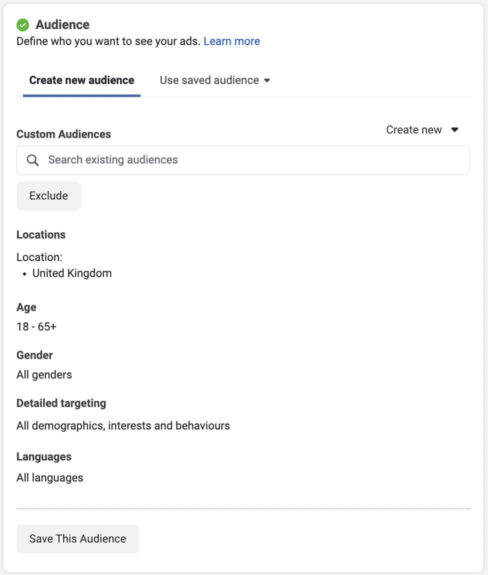
Balancing audience segmentation is crucial to avoid targeting too broadly or narrowly. Marketers often make the mistake of opting for overly broad targeting to ensure coverage, utilizing wide demographic ranges, generic interest terms (e.g., “technology” instead of “game consoles”), or employing all available ad placement options.
-
Improper Ad Set Configurations:
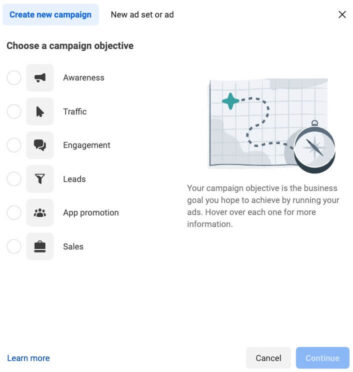
While a small budget and improper objectives don’t directly cause overlap, they can exacerbate the issue. Ads with significant overlap tend to spend more time in the learning phase, where bid costs are higher, amplifying budget constraints. Objectives also influence learning phase duration and the extent of overlap impact.
Additionally, having a too-small budget can diminish the overall value of the ad set due to reduced bid size, resulting in fewer ad displays. Choosing specific objectives can also affect the overlap’s impact. For instance, ads with an awareness objective are less impacted by overlap as the goal is exposure, whereas ads with a lead objective may spend more time in the learning phase, requiring interactions from viewers, which may be limited.
How to Access Facebook Audience Overlap Insights
Accessing insights on audience overlap in Facebook ads is facilitated through Facebook’s dedicated analysis tool, which aids marketers in identifying potential issues.
Here’s how to locate Facebook’s audience overlap tool:
-
Navigate to Your Audience Page
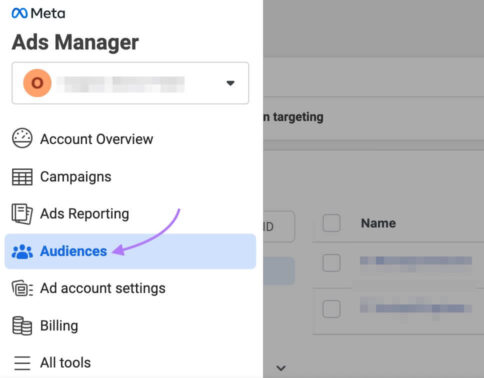
Visit your Meta Ads Manager page. On the left-hand side of the interface, click on the “Audiences” button.
-
Choose Your Audiences
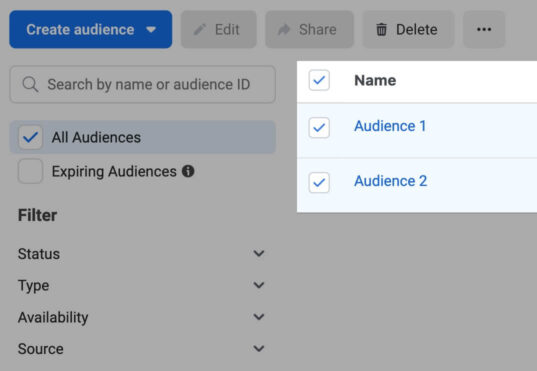
You’ll likely encounter various audiences displayed on the main screen.
Select the ones you wish to examine for overlap.
Identify the ad campaign you suspect may be underperforming and compare it with others targeting audiences sharing similar demographics, interests, or behaviors.
Begin by comparing two ad sets or campaigns with identical objectives, as they are likely to exhibit considerable overlap.
Note: The order of audience selection is critical. Facebook will compare all other audiences against the first one you selected, influencing the ratios and percentages accordingly.
-
Access the Audience Overlap Tool
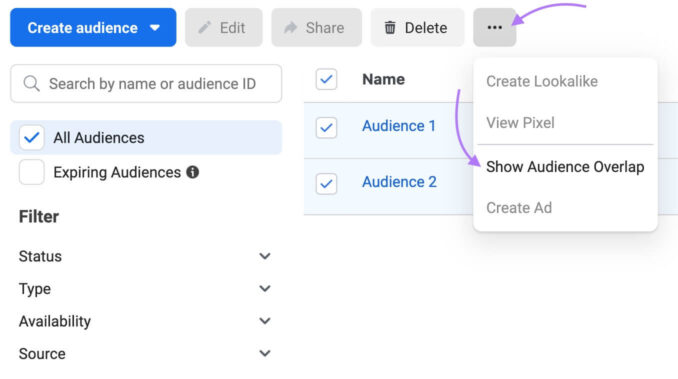
After selecting the desired audiences, click on the three dots located to the right of the “Delete” button. A dropdown menu will appear, revealing the “Show Audience Overlap” option.
Click on this button to compare the selected audiences and evaluate the extent of their overlap.
How to Interpret Audience Overlap Metrics
Understanding the impact of your audience overlap in Facebook ads requires evaluating two key metrics:
- Audience Size
- Audience Overlap Percentage
Audience size refers to the number of active accounts within your specified ad settings. This figure can be adjusted by modifying demographics, locations, behaviors, interests, and other parameters to tailor the audience size accordingly.
The audience overlap percentage indicates the proportion of accounts that belong to two or more overlapping audiences.
It’s important not to overly fixate on these numbers alone, as audience overlap metrics lack meaningful context by themselves.
Consider audience overlap in Facebook ads as a potential concern when troubleshooting issues, rather than viewing it as a predictor of problems, particularly if the overlap is relatively minor.
For instance, if one of your ad sets struggles to exit the learning phase, it’s prudent to investigate potential audience overlap in Facebook ads.
Lastly, there’s a persistent misconception that overlapping audiences lead to competition among ads from the same company, resulting in increased costs and user fatigue.
While this may have been true in the past, Meta has since implemented changes to the behind-the-scenes auction process. Now, when multiple ads from the same account participate in an auction, Meta selects a single ad to compete against ads from other accounts.
How to Avoid Audience Overlap on Facebook Ads
While audience overlap on Facebook ads might not be a major issue, it’s advisable to keep these tactics in mind if a problem arises:
Identify Unique Target Audiences
Narrowing down audiences through specific interest, demographic, or behavior targeting reduces the likelihood of audience overlap on Facebook ads. As audiences become more specific, they tend to overlap with other audiences less.
One of the most effective tools to refine your targeting is to use custom audiences. Custom audiences are a targeting option provided by Facebook that allow you to use your own data, such as website or app activity, to create audiences.
For web activity, you need to first add the Meta Pixel code to your website or application and define standard events (actions that occur on your site).
Next, navigate to your Meta Ads Manager and click on “Audiences.”

Click on “Create audience” and select “Custom Audience.”
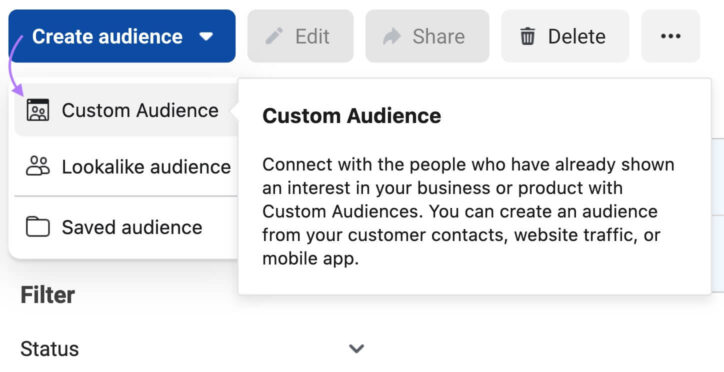
Choose “Website” and click “Next.”
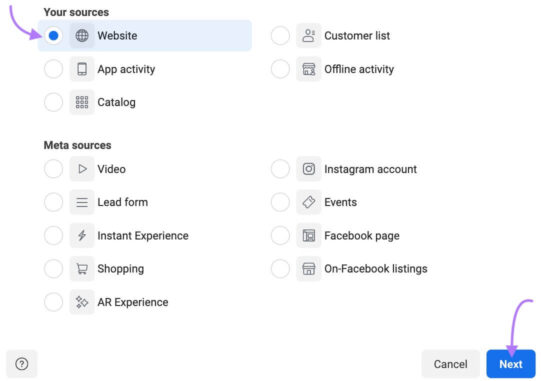
Select your source website, specify whether you want to import all users, and set up retention and inclusion or exclusion criteria.
Finally, provide your audience with a name and description, and click “Create audience.”

Additionally, remember that you can use the lookalike audience option to generate an audience with similar interests to an existing custom audience you have. This helps reduce audience overlap between ad sets on Facebook ads.
To mitigate audience overlap in Facebook ads, leverage the various exclusion options within the Facebook Ads Manager when setting up a new ad campaign.
You can exclude specific segments of audiences to reduce the likelihood of overlap. For instance, you can exclude individuals from previously defined custom audiences (for users utilizing the older version of Meta Ads Manager). Advantage+ users have the option to automatically exclude users who may have previously purchased your product or select custom audiences for exclusion.
Many exclusion targeting options necessitate the use of custom, lookalike, or previously defined audiences.
For users with the original audience options, exclusion options can be utilized by editing an existing campaign or when creating a new one.
In Meta Ads Manager, navigate to the “Audience” section. Locate an existing audience, and click on “Edit.”
Click on the “Add exclusions” or “Exclude” button to access a new menu.
Advantage+ users may encounter a different interface. When creating or editing a campaign, proceed to the “Audience controls” section and click on “Show more options.”
At the bottom of the section, the option to “Exclude these custom audiences” will become visible.
Determining Which Audience to Exclude
Your exclusion strategy depends on your campaign objective. Consider excluding website visitors for awareness campaigns, previous customers for lead generation and sales campaigns, or app users for app promotion.
After creating a new ad campaign, you can effectively prevent overlap by assessing its overlap with existing campaigns using the audience overlap tool. Exclude the campaign with the smaller percentage of overlap from the one with the higher percentage.
Explore Frequency Cap Experimentation
Frequency caps empower you to manually designate the number of times an ad appears to the same individual within a specific timeframe.
Opting for a lower frequency cap reduces ad display frequency but expands the audience reach. Conversely, selecting a higher frequency cap increases ad frequency but limits the audience scope.
To mitigate the impact of audience overlap in Facebook ads, consider a lower frequency cap. This choice provides more opportunities in the ad auction process.
You can fine-tune frequency caps for awareness objectives within the “Awareness” section.
Note: Frequency cap adjustments interact closely with audience size and budget. Consequently, modifying frequency caps may yield negligible effects with a constrained budget or narrow audience targeting.
If you encounter difficulty locating these options, it’s possible that Meta hasn’t yet extended these features to your account.
Utilize Facebook’s Recommendations
The audience overlap tool serves more than just tracking metrics; it also prompts notifications from Facebook if it detects significant overlap issues.
There are two straightforward solutions to tackle audience overlap in Facebook ads.
Firstly, Facebook may propose a series of actions to mitigate audience overlap. These recommendations vary based on your unique circumstances. You might receive delivery recommendations, which include a step-by-step guide.
To access these delivery recommendations, navigate to Meta Ads Manager and click on “Account Overview.”
Note: If no delivery recommendations are visible, they may not be accessible for your account, or you might not have any ad campaigns eligible for optimization.
Alternatively, you can opt to merge or deactivate overlapping ad sets. However, merging sets might impact long-term performance negatively, so deactivating one of the ad sets may be a safer option.
If you’re looking to elevate your marketing strategies or need expert assistance with your Facebook ad account, our dedicated team is here to help. Book a call now to explore how our agency can support you in achieving your advertising goals.
